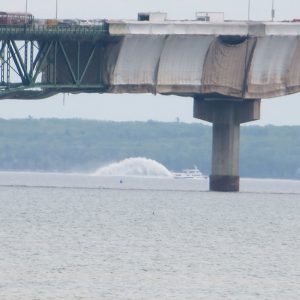
29 Nov Painting The Mackinac Bridge
The Mackinac Bridge is one of the world’s most beautiful bridges and truly something to see. The bridge was designed by the great engineer David B. Steinman and opened on November 1, 1957. The structure took 48 months to complete with over 3, 500 workers and $99,800,000 dollars. Also know as the “Big Mac” or the “Mighty Mac”, the bridge stretches 8,614 feet making it the fourth longest suspension bridge in the world. With a total span of approximately 5 miles, the Mackinac Bridge connects the Upper and Lower Peninsulas of Michigan uniting the communities of Mackinaw City and St. Ignace, Michigan. The main bridge cables are made from 42,000 miles of wire and the towers stand 554 feet above the water and 210 feet below to the bedrock. http://www.mackinac.com/about/mackinac-bridge
What It Takes To Paint The Mackinac Bridge
Crews painting the north span of the Mackinac Bridge this year are using a combination of scaffolding and the safe-span system as a work platform, a work method never seen before on the five-mile suspension bridge. 
A Detroit Tarp containment system surrounds the area where sandblasters and painters work on the Mackinac Bridge. The Safe-Span work platform and scaffolding combination, which allows access for workers and catches any debris before it falls into the water, is a first for Mackinac Bridge painters. To form the containment area where workers sandblast and paint the metal, scaffolding runs down the side of the bridge to sheets of roofing steel held up by a series of wires suspended over the water. From this platform, workers use high-pressure sandblasting and painting equipment to strip down the old coat and repaint every inch of the bridge. Owing to environmental restrictions, crews are required to remove the sand and paint reside from this containment area using a huge vacuum system. The sandblasting, paint spraying, and vacuuming equipment sits atop the bridge surfaces on the anchor piers, pumping clean sand and paint hundreds of feet to workers below and then vacuuming any residue back to towering storage tanks. From the work platform, workers shoot blast sand, called Black Beauty and brought up from Gary, Indiana, stripping down the surface before painters arrive. Three coats of paint are then used in repainting the bridge: A zinc primer coat, epoxy intermediate coat, and urethane final coat, the deep green color motorists have come to associate with the northern Michigan landmark. http://www.stignacenews.com/news/2009-08-20/Front_Page/Mackinac_Bridge_Painters_Use_New_Methods.html

 Detroit Tarp Inc. is a Michigan company and has been a leading manufacture of Water Inflated Cofferdams, Containment Tarps, Trucking Tarps and Custom Tarps for over half a century. We strive to produce quality cost effective products along with great costumer service. We at Detroit Tarp are proud to have played a role in providing the containment tarps for company’s who took part in painting The Mackinac Bridge. The lifespan of the paint being used on this project is estimated at 25 years, although with continual maintenance, it is said they expect it to last closer to 35 years. This will ensure that future generations will be able to enjoy crossing Michigan’s famous Mackinac Bridge into the beautiful Upper Peninsula.
Detroit Tarp Inc. is a Michigan company and has been a leading manufacture of Water Inflated Cofferdams, Containment Tarps, Trucking Tarps and Custom Tarps for over half a century. We strive to produce quality cost effective products along with great costumer service. We at Detroit Tarp are proud to have played a role in providing the containment tarps for company’s who took part in painting The Mackinac Bridge. The lifespan of the paint being used on this project is estimated at 25 years, although with continual maintenance, it is said they expect it to last closer to 35 years. This will ensure that future generations will be able to enjoy crossing Michigan’s famous Mackinac Bridge into the beautiful Upper Peninsula.



No Comments